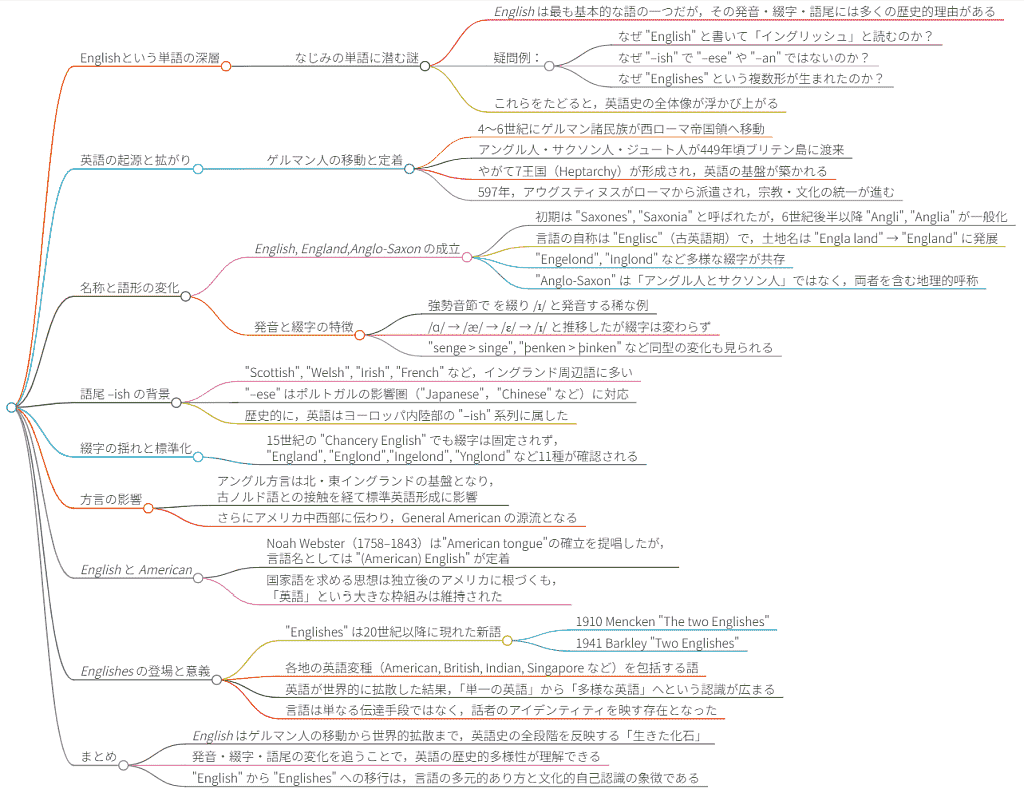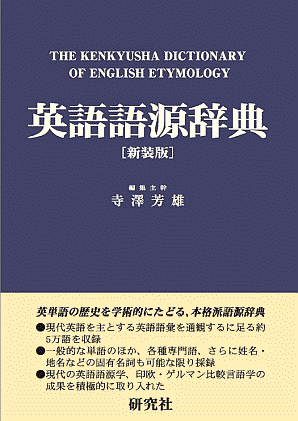2025-11-14 Fri
■ #6045. 「湾」を意味する bay と bight [geography][etymology][kdee][cognate][oe][me][germanic][indo-european][heldio]
先日,ニュージーランドの南島,Christchurch からバスで南へ6時間ほどの Dunedin へ向かった.途中からは,左手の車窓に太平洋を眺めながらの旅だ.地図を見てみると,このルートの東海岸は,「湾」と呼ぶにははばかられるものの,緩やかに内側に湾曲している.後で知ったのだが,このような湾曲の海岸は,bay とはいわずとも bight と呼ばれるらしい.寡聞にして知らない英単語だった.英和辞典には「bay より大きいが奥行が浅い」と説明があった.典型例はオーストラリア南岸の大きな湾曲で,Great Australian Bight と呼ぶらしい.大きな湾としては他に gulf という英単語もあり,地理用語は難しい.
bight という単語を初めて聞いて直感したのは,bight とは語源的にも bay の親戚なのだろうということだ.gh と y は古英語レベルでは互いに異形態であることが多いからだ.
ところが『英語語源辞典』を引いてみて,まったく当てが外れた.これだから語源に関する直感や経験は当てにならない.やはりしっかり辞書で調べてみなければ,正確なとこころは分からないのだ.
まずは,馴染み深い bay のほうから.これは,そもそも本来語ではなく,中期ラテン語の baiam に由来し,古スペイン語での発展形 bahia から古フランス語 baie を経由して,中英語に bai として借用された.Polychronicon に初出している.さらに遡った語源については不詳で,謎の語のようである.
一方,今回注目する bight は,<gh> の綴字からほぼ確実に予想される通り,本来語だった.古英語 byht は「屈曲部,角」を意味し,中英語末期になって「海岸や川の湾曲部,湾」の語義を獲得したという.同根語としてドイツ語 Bucht やオランダ語 bocht があり,ゲルマン祖語形 *buχtiz が再建されている.さらに印欧語根 *bheug- "to bend" に遡り,これは英語の「お辞儀(する)」を意味する bow をも産出している.
常に語源辞典を引く習慣をつけないと引っかかってしまいます,という事例でした.本記事には heldio 版もあります.「#1626. The Canterbury Bight 「カンタベリー湾」」よりお聴きいただければ.
・ 寺澤 芳雄(編集主幹) 『英語語源辞典』新装版 研究社,2024年.
2025-10-13 Mon
■ #6013. 2025年度の朝カルシリーズ講座の第6回「English --- 慣れ親しんだ単語をどこまでも深掘りする」をマインドマップ化してみました [asacul][mindmap][notice][kdee][hee][etymology][hel_education][link][sound_change][spelling_pronunciation_gap][anglo-saxon][jute][history][germanic][oe][world_englishes][demonym][suffix][onomastics]
9月27日(土)に,今年度の朝日カルチャーセンターのシリーズ講座「歴史上もっとも不思議な英単語」の第6回(夏期クールとしては第3回)が新宿教室にて開講されました.テーマは「English --- 慣れ親しんだ単語をどこまでも深掘りする」です.あまりに馴染み深い単語ですが,これだけで90分語ることができるほど豊かなトピックです.
講座と関連して,事前に Voicy heldio にて「#1574. "English" という英単語について思いをめぐらせたことはありますか? --- 9月27日の朝カル講座」を配信しました.
この第6回講座の内容を markmap によりマインドマップ化して整理しました(画像をクリックして拡大).復習用にご参照いただければ.

なお,この朝カル講座のシリーズの第1回から第4回についてもマインドマップを作成しています.
・ 「#5857. 2025年度の朝カルシリーズ講座の第1回「she --- 語源論争の絶えない代名詞」をマインドマップ化してみました」 ([2025-05-10-1])
・ 「#5887. 2025年度の朝カルシリーズ講座の第2回「through --- あまりに多様な綴字をもつ語」をマインドマップ化してみました」 ([2025-06-09-1])
・ 「#5915. 2025年度の朝カルシリーズ講座の第3回「autumn --- 類義語に揉み続けられてきた季節語」をマインドマップ化してみました」 ([2025-07-07-1])
・ 「#5949. 2025年度の朝カルシリーズ講座の第4回「but --- きわめつきの多義の接続詞」をマインドマップ化してみました」 ([2025-08-10-1])
・ 「#5977. 2025年度の朝カルシリーズ講座の第5回「guy --- 人名からカラフルな意味変化を遂げた語」をマインドマップ化してみました」 ([2025-09-07-1])
シリーズの次回,第7回は,10月25日(土)「I --- 1人称単数代名詞をめぐる物語」と題して開講されます.秋期クールの開始となるこの回より,開講時間は 15:30--17:00,開講方式はオンラインのみへ変更となります.ご関心のある方は,ぜひ朝日カルチャーセンター新宿教室の公式HPより詳細をご確認の上,お申し込みいただければ幸いです.
2025-08-15 Fri
■ #5954. 「子供」を意味する古英語 bearn,現代スコットランド方言の bairn について --- ykagata さんのブログ記事より [hee][german][dialectology][oe][scots_english][germanic]

ヘルメイトの ykagata さんが,HatenaBlog 上で展開しているブログ 「blog.heartyfluid --- 勉強したることども」にて,「『英語語源ハンドブック』にこじつけて学ぶドイツ語」と題する魅力的なシリーズを始められている.昨日までに『英語語源ハンドブック』より a/an, baby, cake, dad/daddy, each を取り上げた5つの記事が公開されており,A to Z にかける野心が感じられる.(応援しています!)
8月11日に投稿されたシリーズ第2弾「『英語語源ハンドブック』にこじつけて学ぶドイツ語 #2 baby」より,英単語 baby の他言語への展開の様子をおもしろく読んでいたが,「余談:ゲルマン祖語 *barną 「赤ちゃん」について」の1節に目が留まった.「赤ちゃん」から転じて「子供」を意味するようになった単語として,*barną 系列のものは,現代標準ドイツ語では残っていないという.そこでは,むしろ *kinþą 系の Kind が早くから一般化したとのことだ.ところが,南ドイツ・オーストリア・スイスの一部方言では,*barną 系列の Bua (少年)や Bar/Bärn (子)が用いられているという.
英語史を学んでいると,ここでピンとくる.古英語で「子供;子孫」を意味する頻出語で中性名詞の bearn のことだ.OED によると,この語は中英語では主に barn として存続した(この語形には古ノルド語の同根語が関与している可能性がある)が,後の標準英語にはほとんど残らなかった.しかし,スコットランドでは bairn の形で歴史を通じて使用され続け,現代でも普通に用いられている.標準英語でも1700年以来,文学語として bairn がときに見られるが,これはスコットランド語法の借用と解釈するのがよさそうだ.
ドイツ語においても英語においても,「子供」を意味する類義語間の選択が,方言に応じて割れているというのがおもしろい.動物語や遊びの言葉など,子供が日常的に好むものの名前には方言差が出やすいとされるが,「子供」という語そのものにも類似した傾向があるのだろうか.
2025-04-20 Sun
■ #5837. ito で英語史 --- helito のお題案 [helito][helgame][hel_education][helkatsu][lexicology][loan_word][borrowing][lexical_stratification][french][latin][greek][germanic][etymology][borrowing]
「#5826. 大学院授業で helito をプレイしました --- お題は「英語史用語」」 ([2025-04-09-1]) で紹介したカードゲーム ito (イト)が,hel活界隈で流行ってきています.
heldio/helwa のコアリスナー lacolaco さんが note 記事「英語史×ボードゲーム "helito" やってみた ー helwa 高崎オフ会」でこのゲームを紹介された後,私が上記の hellog 記事を書き,さらにリスナーの川上さんが note で「高校生の「英語のなぜ」やってます通信【番外編1 ito】を公表しました.裏情報ですが,寺澤志帆さんも英語の授業で使用し,みーさんや umisio さんも ito を購入してスタンバイができている状態であると漏れ聞いています.そして,私ももう1つの別の授業で helito を投入しようと思案中です.
ito は,プレイヤー各自が配られた数字カード (1--100) をお題に沿って表現し合い,価値観を共有する助け合いゲームです.言語学用語でいえば「プロトタイプ」 (prototype) を確認しあうことそのものを楽しむゲームとも表現できるかもしれません.英語史で helito するには,どのようなお題がふさわしいか.AIの力も借りながら,いくつかお題案を考えてみました.
(1) 古英語っぽさ・現代英語っぽさ
単語のもつ雰囲気,発音,綴字などから,古英語寄り(1に近い数)か現代英語寄り(100に近い数)かを判断します.例えば,(ge)wyrd (運命)は古英語らしさ(1点)を,globalization (グローバル化)は現代英語らしさ(100点)を感じさせるかもしれません.古英語や中英語の知識が試されます.
(2) 借用語が借用された時期
英語に入った借用語 (loan_word) について,その借入時期の古さ・新しさを判定します.例えば,ラテン語由来の street や古ノルド語由来の sky は古く(1に近い),日本語由来の sushi や anime は非常に新しい(100に近い)借用といえます.英単語の語源の知識が試されます.
(3) 語種
英語の語彙を,主要な系統(すなわち語種)に基づき分類します.ゲルマン語派 (germanic),フランス語 (french),ラテン語 (latin),ギリシア語 (greek)などをひとまず想定しましょう.man のようなゲルマン系の基本語であれば1点に近く,justice のようなフランス借用語は50点付近,philosophy のような学術語は100点に近づく,などの尺度が考えられます.英語語彙の「3層構造」を理解している必要があります.ただ,必ずしも綺麗な連続体にならないので,ゲームとしては少々苦しいかもしれません.
(4) 「食」に関する語彙
(3) の応用編ともいえますが,語彙のテーマを「食」に絞った応用編です.ゲルマン系の素朴な食材を表わす語(bread など)と,フランス語由来の洗練された食文化を体現する語(cuisine など)を対比させます.著名な cow (動物・ゲルマン系) vs. beef (食肉・フランス系) のような対立もこのお題で扱えそうです.このようなテーマ別の語彙に基づく helito では,語彙と語源の豊富な知識が必要であり,難易度はかなり高いかもしれません.
その他,helito にはどのようなお題が考えられるでしょうか.
2025-01-09 Thu
■ #5736. アイルランド語 (Irish) とアイルランド英語 (Irish English) はまったく異なる言語である [irish][irish_english][ireland][contact][history][sociolinguistics][variety][germanic][celtic]
標題の2つの言語(変種)は,名前が似ているので,ときに同一物と誤解されることがある.両者ともアイルランド島(特にアイルランド共和国)と結びついていることは確かだが,言語的には完全に異なるものである.
アイルランド語 (Irish) は印欧語族のケルト語派に属する1言語であり,古来アイルランドの土地と結びつけられてきた.その点ではアイルランドの土着言語といってよい.
一方,アイルランド英語 (Irish English/Hiberno-English) は,同じ印欧語族に属するとはいってもゲルマン語派に属する1言語である英語 (English) の,そのまた枝分かれした方言の1つである.ちょうどアメリカ英語,インド英語が,それぞれアメリカ訛りの英語,インド訛りの英語と理解してよいように,アイルランド英語はアイルランド訛りの英語である.英語の1変種ということだ.
語族は同じでも語派が異なれば,事実上,完全に別の言語といってよい.誤解を恐れずにいえば,アイルランド語とアイルランド英語は,日本語と英語ほどに異なる,と述べておこう.
近代以降,イングランドはアイルランドに対する政治・文化的影響力を獲得していったが,その過程で,外来の英語が土着のアイルランド語を徐々に置き換えていったという歴史がある.かくして,現代までにアイルランドは事実上,英語が支配する土地となった.現在,古来の土着言語であるアイルランド語は,アイルランド島の西部において人口のわずか2%ほどによって話される少数言語となっている.これは「#2803. アイルランド語の話者人口と使用地域」 ([2016-12-29-1]) で見たとおりである.
アイルランド語とアイルランド英語は完全に別物と述べたが,その上で,後者は前者の風味を含んでいるという事実も指摘しておきたい.アイルランド語が土着言語であるところへ,後から英語が移植されたわけなので,そこで育っていくことになる英語変種も,基層にあったアイルランド語の言語的特徴をある程度ピックアップすることになったので,これは当然といえば当然である.
嶋田 (184) より「アイルランドの言語史スケッチ」として図示されている関連する略年表を掲げておこう.
1600 北部から東部へイギリスの入植
| ~(I)アイルランド語と英語の言語接触
| 〈二言語使用が進む〉
1840s 大飢饉.アイルランド語母語話者の減少
| 〈母語としてのアイルランド語の継承が困難に〉
1900 〈言語交替の加速化〉
| ~(II)安定したアイルランド英語の形成から
1970s メディアの広がり,EC加盟,教育の普及
| ~(III)アイルランド英語と主要英語変種との接触から
2000 経済成長,グローバリゼーション
|
締めくくりとして,嶋田 (186) の言葉を引用しておきたい.
アイルランド英語は,昔アイルランドにあったことばではなく,アイルランド語と英語の接触によって生まれた言語が現在まで続いてきたところのことばである.すなわち,アイルランド英語は,アイルランドで育ったことばが脈々と今日まで続いている連続体としてとらえることができる.
嶋田珠巳先生(明海大学)は,アイルランドの言語事情に詳しい社会言語学者である.とりわけ以下の著書をお薦めしておきたい.

本ブログでも,関連する記事として「#2798. 嶋田 珠巳 『英語という選択 アイルランドの今』 岩波書店,2016年.」 ([2016-12-24-1]),「#1715. Ireland における英語の歴史」 ([2014-01-06-1]),「#2803. アイルランド語の話者人口と使用地域」 ([2016-12-29-1]),「#2804. アイルランドにみえる母語と母国語のねじれ現象」 ([2016-12-30-1]) を公開してきた.
先日1月2日の Voicy helwa (有料配信)にて「【英語史の輪 #232】アイルランドの英語史」と題する回を配信した.ご関心のある方は,ぜひそちらもどうぞ.
・ 嶋田 珠巳 『英語という選択 アイルランドの今』 岩波書店,2016年.
2024-11-28 Thu
■ #5694. ゲルマン民族・ドイツ語純粋主義の言説について --- 池上俊一(著)『森と山と川でたどるドイツ史』より [purism][germanic][language_myth][linguistic_ideology]
3日前の記事「#5691. 池上俊一(著)『森と山と川でたどるドイツ史』(岩波書店〈岩波ジュニア新書〉,2015年)の目次」 ([2024-11-25-1]) で紹介した書籍より,ゲルマン民族・ドイツ語純粋主義の言説について,著者の解説を引用したい.本書の最後の第7章の「政治と結びつく危険性」と題する1節 (206--07) より.
ドイツ人は二〇〇〇年近くにわたって,具体的な自然を活用して生活に役立てるだけでなく,より深い精神的・身体的な交流をもってきました.それが,彼らを政治的不安定・未確定の宙吊り状態の不安から救い,安心感,誇りと名誉の感覚さえ与えてきたのです.
パリやロンドンのような中心もなければ拠るべきギリシャ・ローマの伝統やキリスト教の伝統もない,しかもおびただしい領邦に分断されたドイツ人が,自己の定着地として認められるのは,曖昧だが根源的な自然や風景であって,生命とエロスが躍動しているーー個体としての人間とその魂がごく一部を構成するーー有機体世界=自然世界でした.
ですから一九世紀になって,ドイツにナショナリズムがわきおこってきたとき,根源とか自然とか,家郷とか祖国とか,血縁とか地縁などとの,情感あふれる結びつきに深く訴えながらのプロパガンダがくり広げられました.まさにウェットなナショナリズムなのですが,その大元には,ドイツ人にとっては「自然」こそが「家郷」であり,そこから引き離されてはドイツ人のドイツ人たる存在理由がなくなる,という思いがあったのです.
この独特な自然観を深く考察した当時の思想家たちによると,その「自然」には「言語」との密接な連関がありました.そして「ドイツ人の祖先はーー他のゲルマン民族とは異なりーー原民族の居住地にずっと止まり,かつもとの言語をそのまま維持した」「だからドイツ民族のみが根元とつながっており,そこに真に固有文化が育つのだ」と主張されました.
ここでは「言語」こそがひとつの「民族」の基礎をなすものであり,それがあたかも,植物や動物であるかのように分化し,成長していくととらえられています.「ドイツ人は言語も自然の根源性につながっているのに,他の諸民族は余所の言語を受け容れたり,故地から別の地域に移動して堕落し,文化も停滞してしまった」とされるのです.
このような考えに立てば「ドイツ語が話されているすべての地域がドイツとして統一されるべきだ」ということになり,このドイツ民族中心主義が,純血主義や世界主義と結びついていくとどんな恐ろしい結果がおきるかは,ナチ・ドイツが赤裸々に示したとおりです.
ドイツ語が「もとの言語をそのまま維持した」と考えられた際に,比較対照されたゲルマン諸語の筆頭はおそらく英語と考えてよいだろう.歴史的にみても,英語ほど純粋でないゲルマン語はないからだ.あまつさえ,英語は世界語の地位を得つつある著名な言語でもある.もちろん英語(の歴史)そのものに罪はないが,英語がゲルマン民族・ドイツ語純粋主義の言説のために引き合いに出されたということは十分にありそうだ

・ 池上 俊一 『森と山と川でたどるドイツ史』 岩波書店〈岩波ジュニア新書〉,2015年.
2024-11-25 Mon
■ #5691. 池上俊一(著)『森と山と川でたどるドイツ史』(岩波書店〈岩波ジュニア新書〉,2015年)の目次 [toc][history][review][germanic]

岩波ジュニア新書のドイツ史入門書.地勢の観点からドイツの歴史をたどります.中高生向けのシリーズですが,大人が読んでもたいへん勉強になる1冊です.内容は英語史とは斜めの関係になりますが,「ゲルマン民族」を理解しておくことは,英語史の学びにとっても重要です.以下,本書の目次を挙げておきます.
はじめに
第1章 ゲルマンの森とその支配
地勢と気候
ゲルマン人の侵入とローマ帝国の滅亡
フランク王国の建国と分裂
神聖ローマ帝国誕生
ゲルマンの森とその神話
神聖なる菩提樹
王の森から領主の森へ
森の恵み,ハム・ソーセージ
狩猟文化とその継続
地中海から内陸河川へ
第2章 山と川に拠る生活
聖職叙任権闘争の背景
領邦分立の時代へ
中世農民の状況
東方植民はなぜ必要だったのか
山の城に割拠する領主たち
川沿いの都市建設
ハンザ同盟と海をめぐる都市
アルプスと峠道
森の化身としての野人
ふしぎな力をもつ修道女
第3章 宗教改革と自然の魔力
ルターと宗教闘争
領邦教会の誕生
ドイツ農民戦争と自然
ブロッケン山の伝説
魔女迫害の真相
なぜドイツは魔女が多かったのか
王宮がおかれた鉱山町ゴスラー
フッガー家と鉱山開発
各地に散らばる鉱山町
塩が支えた都市の発展
自然学と錬金術
グラウバーの『ドイツの繁栄』
第4章 ハプスブルク帝国からドイツ帝国へ
三十年戦争とその結果
プロイセン対オーストリア
領邦の中の都市
啓蒙専制君主フリードリッヒ二世とジャガイモ
ドイツ啓蒙主義の評価
公共の場の出現と家庭での感情生活
領主を利する農業改革
森の荒廃と復元
第5章 産業発展と山の賜物
実を結ばない社会改革
ナポレオンが喚起した愛国心
プロイセンによる統一へ
山の湯治場
温泉好きのゲーテ
登山の時代
鉄鋼業が牽引する経済
ルール地方の重工業の発展
現在に続く「メイド・イン・ジャーマニー」
すたれない河川輸送
父なるライン川
ドナウ川とエルベ川
河川にみる自然の改変
自然をあがめるドイツ・ロマン主義文学
山岳絵画と有機体思想
第6章 自然崇拝の明暗
ビスマルク退場からヴィルヘルム二世の親政へ
第一次世界大戦の勃発とワイマール体制
ヒトラーと第二次世界大戦
ワンダーフォーゲルにはまる若者たち
トゥルネン運動
すばらしき林業
森林の保全とエコシステム
無意識という地層
「音楽の国ドイツ」の神話
「清潔なる帝国」
ナチと自然保護
クラインガルテン運動
第7章 経済大国からエコ大国へ
ヨーロッパの中のドイツ
ドイツ再統一へ
過去の克服はできたのか
遅れてきた国民
遅れの創造性
自然との深い関わり
政治と結びつく危険性
上へ上へ
秩序の追求
環境先進国へ
あとがき(参考文献)
ドイツ史年表
・ 池上 俊一 『森と山と川でたどるドイツ史』 岩波書店〈岩波ジュニア新書〉,2015年.
2024-11-23 Sat
■ #5689. 11月30日(土)の朝カルのシリーズ講座第8回「英語,オランダ語と交流する」のご案内 [asacul][notice][kdee][etymology][hel_education][helkatsu][link][lexicology][vocabulary][dutch][afrikaans][flemish][borrowing][loan_word][contact][germanic][japanese][historiography][voicy][heldio]

・ 日時:11月30日(土) 17:30--19:00
・ 場所:朝日カルチャーセンター新宿教室
・ 形式:対面・オンラインのハイブリッド形式(1週間の見逃し配信あり)
・ お申し込み:朝日カルチャーセンターウェブサイトより
今年度の朝カルシリーズ講座「語源辞典でたどる英語史」が,月に一度のペースで順調に進んでいます.主に『英語語源辞典』(研究社)を参照しながら,英語語彙史をたどっていくシリーズです.
1週間後に開講される第8回ではオランダ語と英語の言語接触に迫ります.後期中英語期には,イングランドはオランダを含む低地帯 (the Low Countries) との商業的な交流が盛んで,言語的にも濃い接触があったと考えられています.しかし,伝統的な英語史記述においては,オランダ語との言語接触は,ラテン語,フランス語,古ノルド語などとの言語接触に比べて注目度が低く,大々的に話題にされることはほとんどありません.重要なオランダ借用語をいくつか挙げて終わり,ということが一般的です.しかし,オランダ語の英語への影響は潜在的には一般に考えられている以上に大きく,講座1回分の議論の価値は十分にあると思われます.
今回の講座では,ゲルマン語派におけるオランダ語(および関連諸言語・方言)の位置づけを確認しつつ,同言語が英語の語彙やその他の部門に与えた影響について議論します.また,背景としての英蘭関係史にも注目します.さらに,オランダ単語が日本語語彙に多く入り込んでいる事実にも注目したいと思います.
本シリーズ講座の各回は独立していますので,過去回への参加・不参加にかかわらず,今回からご参加いただくこともできます.過去7回分については,各々概要をマインドマップにまとめていますので,以下の記事をご覧ください.
・ 「#5625. 朝カルシリーズ講座の第1回「英語語源辞典を楽しむ」をマインドマップ化してみました」 ([2024-09-20-1])
・ 「#5629. 朝カルシリーズ講座の第2回「英語語彙の歴史を概観する」をマインドマップ化してみました」 ([2024-09-24-1])
・ 「#5631. 朝カルシリーズ講座の第3回「英単語と「グリムの法則」」をマインドマップ化してみました」 ([2024-09-26-1])
・ 「#5639. 朝カルシリーズ講座の第4回「現代の英語に残る古英語の痕跡」をマインドマップ化してみました」 ([2024-10-04-1])
・ 「#5646. 朝カルシリーズ講座の第5回「英語,ラテン語と出会う」をマインドマップ化してみました」 ([2024-10-11-1])
・ 「#5650. 朝カルシリーズ講座の第6回「英語,ヴァイキングの言語と交わる」をマインドマップ化してみました」 ([2024-10-15-1])
・ 「#5669. 朝カルシリーズ講座の第7回「英語,フランス語に侵される」をマインドマップ化してみました」 ([2024-11-03-1])
本講座の詳細とお申し込みはこちらよりどうぞ.『英語語源辞典』(研究社)をお持ちの方は,ぜひ傍らに置きつつ受講いただければと存じます(関連資料を配付しますので,辞典がなくとも受講には問題ありません).

(以下,後記:2024/11/27(Wed))
・ 寺澤 芳雄(編集主幹) 『英語語源辞典』新装版 研究社,2024年.
2024-11-17 Sun
■ #5683. 英語本来語かオランダ借用語かの判定が難しい理由 [dutch][low_german][flemish][contact][lexicology][borrowing][loan_word][germanic][old_norse][evidence]
昨日の記事「#5682. Low Dutch という略称」 ([2024-11-16-1]) で,オランダ語やそれと関連する言語変種からの語彙借用の話題に触れた.過去の記事でも,同じ関心から「#4445. なぜ英語史において低地諸語からの影響が過小評価されてきたのか?」 ([2021-06-28-1]) などで議論してきた.
英語とオランダ語はともに西ゲルマン語派の低地ドイツ語群に属しており,単語もよく似ている.したがって,ある英単語が歴史的に英語本来語なのかオランダ借用語なのかを確信をもって判定するのは,しばしば困難である.この困難の背景について,Durkin (356) がもう少し丁寧に解説しているので,引用したい.
Normally such certainty is only available in cases where the absence of an English sound change or the presence of a Dutch or Low German one demonstrates borrowing: the situation is similar to that explored with reference to early Scandinavian borrowings . . . , with the added complication that there are fewer sound changes distinguishing English from Dutch and Low German. The same problem even affects some words first attested much later than the Middle English period, especially those found in regional varieties for which earlier evidence is in very short supply.
英語本来語かオランダ借用語か否かの判定において,音変化の有無の対比といった言語内的な証拠に訴えかけられるチャンスが低いという点が悩ましい.この点で古ノルド借用語の判定にかかわる困難とも比較されるが,古ノルド語の場合には,北ゲルマン語派に属する言語なので,もう少し言語内的な差異に頼ることができるのだろう.
また,現存する歴史的証拠が乏しい地域変種における語彙となると,さらに判定が困難になるというのもうなずける.個々の単語について,言語内的な証拠だけでなく言語外的な証拠をも収集し,厳密に考慮していかなければならない所以である.
・ Durkin, Philip. Borrowed Words: A History of Loanwords in English. Oxford: OUP, 2014.
2024-11-16 Sat
■ #5682. Low Dutch という略称 [dutch][low_german][flemish][contact][lexicology][borrowing][loan_word][terminology][germanic][variety]
「#2646. オランダ借用語に関する統計」 ([2016-07-25-1]) で,英語史におけるオランダ借用語をめぐって Durkin を参照した.そこで Dutch でも Low German でもなく,中間的な Low Dutch という用語が使われていた.これが何を指すのかといえば,Durkin 自身が丁寧に解説してくれていた.その1節 (354) を読んでみよう.
Loanwords into English from Dutch (including Flemish) and Low German are normally considered together, because it is so difficult to tell them apart. This is partly because word forms in both languages were, and to some extent still are, so similar, and partly because the social and cultural circumstances of borrowing into English are also often hard to tell apart. 'Low Dutch' is sometimes used as a collective cover term for borrowings from either or both languages into English, although it is important to note that Low Dutch is not itself a language name, but simply a terminological shorthand for referring to a complex situation.
Dutch と Low German は各々区別される言語変種ではあるが,単語の形態が互いによく似ており,借用元同定の文脈においては,実際上区別がつかないことも多いために,便宜上2変種を合わせた用語として Low Dutch を設定しておく,ということだ.ある意味で Low Dutch はフィクションということになる.フランス借用語かラテン借用語か判別がつきにくいときに,便宜上「フランス・ラテン系借用語」などと一括して呼ぶのに似ている.
しかし,こうした用語のフィクション性それ自体も程度の問題ともいえるかもしれない.というのは,上記の Dutch にしても Low German にしても,「区別される言語変種」と一応のところ述べはしたが,やはり何らかの程度においてフィクションでもあるからだ.この点については「#415. All linguistic varieties are fictions」 ([2010-06-16-1]) を参照.
便利に使えるのであれば Low Dutch というタームは悪くない.
・ Durkin, Philip. Borrowed Words: A History of Loanwords in English. Oxford: OUP, 2014.
2024-09-14 Sat
■ #5619. 9月28日(土)の朝カル新シリーズ講座第6回「英語,ヴァイキングの言語と交わる」のご案内 [asacul][notice][kdee][etymology][hel_education][helkatsu][link][lexicology][vocabulary][oe][old_norse][germanic][contact][voicy][heldio]

・ 日時:9月28日(土) 17:30--19:00
・ 場所:朝日カルチャーセンター新宿教室
・ 形式:対面・オンラインのハイブリッド形式(見逃し配信あり)
・ お申し込み:朝日カルチャーセンターウェブサイトより
2週間後の9月28日(土)17:30--19:00に朝日カルチャーセンター新宿教室にてシリーズ講座「語源辞典でたどる英語史」の第6回となる「英語,ヴァイキングの言語と交わる」を開講します.
前回8月24日の第5回では「英語,ラテン語と出会う」と題して,古英語期(あるいはそれ以前の時代)におけるラテン語の語彙的影響に注目しました.今回は8世紀後半から11世紀前半にかけてのヴァイキング時代に焦点を当て,古ノルド語 (old_norse) と古英語の言語接触について解説します.
ヴァイキングとは上記の時期に活動したスカンジナビア出身の海賊を指します.彼らはブリテン島にも襲来し,やがてイングランド東部・北部に定住するようになりました.その結果,古ノルド語を母語とするヴァイキングと古英語を話すアングロサクソン人との間で言語接触が起こりました.
古ノルド語からの借用語は,現代英語に900語ほど残っています.この絶対数はさほど大きいわけではありませんが,基本語や機能語など高頻度で使用される語が多く含まれているのが注目すべき特徴です.講座では具体的な古ノルド語からの借用語を取り上げ,その語源を読み解いていきます.
古ノルド語と英語の接触は非常に濃密なものでした.これは両言語がゲルマン語族に属しており,近い関係にあったことや,両民族の社会的な交流の深さを反映していると考えられます.ヴァイキングの活動を通じた古ノルド語との接触は,英語の語彙に(そして実は文法にも)多大な影響を与えました.現代英語の姿を理解する上で,この歴史的な言語接触の重要性は看過できません.
本シリーズ講座は各回の独立性が高いので,第6回からの途中参加でもまったく問題なく受講できます.新宿教室での対面参加のほかオンライン参加も可能ですし,その後1週間の「見逃し配信」もご利用できます.奮ってご参加ください.お申し込みはこちらよりどうぞ.
なお,本シリーズ講座は「語源辞典でたどる英語史」と題しているとおり,とりわけ『英語語源辞典』(研究社)を頻繁に参照します.同辞典をお持ちの方は,講座に持参されると,より楽しく受講できるかと思います(もちろん手元になくとも問題ありません).

(以下,後記:2024/09/21(Sat))
・ 寺澤 芳雄(編集主幹) 『英語語源辞典』新装版 研究社,2024年.
2024-07-21 Sun
■ #5564. 古英語のラテン語からの借用語はせいぜい数百語 [oe][loan_word][borrowing][latin][old_norse][celtic][latin][germanic][lexicology][link]
古英語の語彙は相当程度にピュアなゲルマン系の語彙といってよく,借用語は限られている.しかも,その限られた借用語の大部分がラテン語 (latin) からのものである.ほかには古ノルド語 (old_norse),ケルト語 (celtic),ゲルマン諸語 (germanic), フランス語 (french) からの借用語もないではないが,あくまで影は薄い.
これらの言語から古英語への借用語は,むしろ例外的だからこそ気になるのだろう.数が少ないので,古英語を読んでいるときに出くわすとやけに目立つのである.英語史研究でもかえってよく注目されている.Hogg は,古英語期の語彙と語彙借用について次のように評している.
. . . there are words of non-native origin in Old English, the vast majority of which are from Latin. It has been estimated only about 3 per cent of Old English vocabulary is taken from non-native sources and it is clear that the strong preference in Old English was to use its native resources in order to create new vocabulary. In this respect, therefore, and as elsewhere, Old English is typically Germanic. (102--03)
. . . there was in Old English only a very limited use of words taken from other language, i.e. borrowed or loan words, and those words were primarily from Latin. Apart from Latin, Old English borrowed words from the Scandinavian languages after the Viking invasions, from the celtic languages mostly at a very early date, and there was also a scattering of forms from the other Germanic languages. At the very end of the period we begin to see the first loan words from Norman French. (109)
古英語期の各言語からの語彙借用については,以下の記事を参照.
・ 「#32. 古英語期に借用されたラテン語」 ([2009-05-30-1])
・ 「#1437. 古英語期以前に借用されたラテン語の例」 ([2013-04-03-1])
・ 「#1619. なぜ deus が借用されず God が保たれたのか」 ([2013-10-02-1])
・ 「#1945. 古英語期以前のラテン語借用の時代別分類」 ([2014-08-24-1])
・ 「#2578. ケルト語を通じて英語へ借用された一握りのラテン単語」 ([2016-05-18-1])
・ 「#3787. 650年辺りを境とする,その前後のラテン借用語の特質」 ([2019-09-09-1])
・ 「#3788. 古英語期以前のラテン借用語の意外な日常性」 ([2019-09-10-1])
・ 「#3789. 古英語語彙におけるラテン借用語比率は1.75%」 ([2019-09-11-1])
・ 「#3790. 650年以前のラテン借用語の一覧」 ([2019-09-12-1])
・ 「#3829. 650年以後のラテン借用語の一覧」 ([2019-10-21-1])
・ 「#3830. 古英語のラテン借用語は現代まで地続きか否か」 ([2019-10-22-1])
・ 「#1216. 古英語期のケルト借用語」 ([2012-08-25-1])
・ 「#3821. Old Saxon からの借用語」 ([2019-10-13-1])
・ 「#302. 古英語のフランス借用語」 ([2010-02-23-1])
・ Hogg, Richard. An Introduction to Old English. Edinburgh: Edinburgh UP, 2002.
2024-07-16 Tue
■ #5559. 古英語の形容詞の弱変化・強変化屈折はどこから来たのか? [oe][adjective][inflection][germanic][noun][personal_pronoun][suffix][indo-european][terminology]
「#2560. 古英語の形容詞強変化屈折は名詞と代名詞の混合パラダイム」 ([2016-04-30-1]) でみたように,古英語の形容詞の屈折には統語意味的条件に応じて弱変化 (weak declension) と強変化 (strong declension) が区別される.
それぞれの形態的な起源は,先の記事で述べた通りで,名詞の弱変化と強変化にストレートに対応するわけではなく,やや込み入っている.形容詞の弱変化は,確かに名詞の弱変化と対応する.n-stem や子音幹とも言及される通り,屈折語尾に n 音が目立つ.Fertig (38) によると,弱変化の屈折語尾は,もともとは個別化機能 (= "individualizing function") を有する派生接尾辞に端を発するという.個別化して「定」を表わすからこそ,ゲルマン語派では "definiteness" と結びつくようになったのだろう.
一方,形容詞の強変化の屈折語尾は,必ずしも名詞の強変化のそれに似ていない.むしろ,形態的には代名詞のそれに類する.いかにして代名詞的な屈折語尾が形容詞に侵入し,それを強変化となしたのかはよく分からない.しかし,これによって形容詞が形態的には名詞と一線を画する語類へと発展していったことは確かだろう.
Fertig (39--40) より,関連する説明を引いておこう.
Originally, the function of this new distinction in Germanic involved definiteness (recall the original 'individualizing' function of the -en suffix in Indo-European): strong = indefinite, blinds guma 'a blind man'; weak = definite, blinda guma 'the blind man').
The other Germanic innovation which may not be entirely separable from the first one, is that many of the endings on the strong forms of adjectives do not correspond to strong noun forms, as they had in Indo-European. Instead, they correspond largely to pronominal forms . . . .
古英語の名詞,形容詞,そして動詞でいうところの「弱変化」と「強変化」は,それぞれ意味合いが異なることに改めて注意したい.
・ Fertig, David. Analogy and Morphological Change. Edinburgh: Edinburgh UP, 2013.
2024-07-02 Tue
■ #5545. 古英語の定冠詞・疑問詞の具格 [oe][article][determiner][interrogative_pronoun][case][instrumental][inflection][etymology][comparative_linguistics][germanic]
昨日の記事「#5544. 古英語の具格の機能,3種」 ([2024-07-01-1]) に引き続き,具格 (instrumental) について.古英語の定冠詞(あるいは決定詞) (definite article or determiner) の屈折表を「#154. 古英語の決定詞 se の屈折」 ([2009-09-28-1]) で示した.それによると,þȳ, þon といった独自の形態をとる具格形があったことがわかる.同様に疑問(代名)詞 (interrogative_pronoun) についても,その屈折表を「#51. 「5W1H」ならぬ「6H」」 ([2009-06-18-1]) に示した.そこには hwȳ という具格形が見られる.
Lass (144) によると,これらの具格形は比較言語学的にも,直系でより古い形に遡るのが難しいという.純粋な語源形が突きとめにくいようだ.この辺りの事情を,直接 Lass に語ってもらおう.
There are remains of what is usually called an 'instrumental' in the masculine and neuter sg; this term as Campbell remarks 'is traditional, but reflects neither their origin nor their prevailing use' (1959: §708n). The two forms are þon, þȳ, neither of which is historically transparent. In use they are most frequent in comparatives, e.g. þȳ mā 'the more' (cf. ModE the more, the merrier), and as alternatives to the dative in expressions like þȳ gēare '(in) this year'. There is probably some relation to the 'instrumental' interrogative hwȳ 'why?', which in sense is a real one (= 'through/by what?'), but the /y:/ is a problem; hwȳ has an alternative form hwī, which is 'legitimate' in that it can be traced back to the interrogative base */kw-/ + deictic */ei/.
比較言語学の手に掛かっても,すべての語源を追いかけて明らかにすることは至難の業のようだ.
・ Lass, Roger. Old English: A Historical Linguistic Companion. Cambridge: CUP, 1994.
・ Campbell, A. Old English Grammar. Oxford: OUP, 1959.
2024-03-11 Mon
■ #5432. 複数形の -(r)en はもともと派生接尾辞で屈折接尾辞ではなかった [exaptation][language_change][plural][morphology][derivation][inflection][indo-european][suffix][rhotacism][sound_change][germanic][german][reanalysis]
長らく名詞複数形の歴史を研究してきた身だが,古英語で見られる「不規則」な複数形を作る屈折接尾辞 -ru や -n がそれぞれ印欧祖語の段階では派生接尾辞だったとは知らなかった.前者は ċildru "children" などにみられるが,動作名詞を作る派生接尾辞だったという.後者は ēagan "eyes" などにみられるが,個別化の意味を担う派生接尾辞だったようだ.
この点について,Fertig (38) がゲルマン諸語の複数接辞の略史を交えながら興味深く語っている.
There are a couple of cases in Germanic where an originally derivational suffix acquired a new inflectional function after regular phonetic attrition at the ends of words resulted in a situation where the suffix only remained in certain forms in the paradigm. The derivational suffix *-es-/-os- was used in proto-Indo-European to form action nouns . . . . In West Germanic languages, this suffix was regularly lost in some forms of the inflectional paradigm, and where it survived it eventually took on the form -er (s > r is a regular conditioned sound change known as rhotacism). The only relic of this suffix in Modern English can be seen in the doubly-marked plural form children. It played a more important role in noun inflection in Old English, as it still does in modern German, where it functions as the plural ending for a fairly large class of nouns, e.g. Kind--Kinder 'child(ren)'; Rind--Rinder 'cattle'; Mann--Männer 'man--men'; Lamm--Lämmer 'labm(s)', etc. The evolution of this morpheme from a derivational suffix to a plural marker involved a complex interaction of sound change, reanalysis (exaptation) and overt analogical changes (partial paradigm leveling and extension to new lexical items). A similar story can be told about the -en suffix, which survives in modern standard English only in oxen and children, but is one of the most important plural endings in modern German and Dutch and also marks a case distinction (nominative vs. non-nominative) in one class of German nouns. It was originally a derivational suffix with an individualizing function . . . .
child(ren), eye(s), ox(en) に関する話題は,これまでも様々に取り上げてきた.以下のコンテンツ等を参照.
・ hellog 「#946. 名詞複数形の歴史の概要」 ([2011-11-29-1])
・ hellog 「#146. child の複数形が children なわけ」 ([2009-09-20-1])
・ hellog 「#145. child と children の母音の長さ」 ([2009-09-19-1])
・ hellog 「#218. 二重複数」 ([2009-12-01-1])
・ hellog 「#219. eyes を表す172通りの綴字」 ([2009-12-02-1])
・ hellog 「#2284. eye の発音の歴史」 ([2015-07-29-1])
・ hellog-radio (← heldio の前身) 「#31. なぜ child の複数形は children なのですか?」
・ heldio 「#202. child と children の母音の長さ」
・ heldio 「#291. 雄牛 ox の複数形は oxen」
・ heldio 「#396. なぜ I と eye が同じ発音になるの?」
・ Fertig, David. Analogy and Morphological Change. Edinburgh: Edinburgh UP, 2013.
2024-02-21 Wed
■ #5413. ゲルマン祖語と古英語の1人称単数代名詞 [comparative_linguistics][personal_pronoun][pronoun][person][germanic][reconstruction][paradigm][oe][indo-european][rhotacism][analogy][sound_change]
Hogg and Fulk (202--203) を参照して,ゲルマン祖語 (Proto-Germanic) と古英語 (Old English) の1人称単数代名詞の格屈折を並べて示す.
| PGmc | OE | |
|---|---|---|
| Nom. | *ik | iċ |
| Acc. | *mek | mē |
| Gen. | *mīnō | mīn |
| Dat. | *miz | mē |
表の左側の PGmc の各屈折が,いかにして右側の OE の形態へ変化したか.ここにはきわめて複雑な類推 (analogy や音変化 (sound_change) やその他の過程が働いているという.Hogg and Fulk (203) の解説をそのまま引用しよう.
nom.sg.: *ik must have been the unstressed form, with analogical introduction of its vowel into the stressed form, with only ON ek showing retention of the original stressed vowel amongst the Gmc languages (cf. Lat egō/ǒ).
acc.sg.: *mek is the stressed form; all the other Gmc languages show generalization of unstressed *mik. The root is *me-, with the addition of *-k borrowed from the nom. The form mē could be due to loss of *-k when *mek was extended to unstressed positions, with lengthening of the final vowel when it was re-stressed . . . . More likely it represents replacement of the acc. by the dat. . . . as happened widely in Gmc and IE . . . .
gen.sg.: To the root *me- was added the adj. suffix *-īn- (cf. stǣnen 'made of stone' < *stain-īn-a-z . . .), presumably producing *mein- > *mīn- . . . . To this was added an adj. ending, perhaps nom.acc.pl. neut. *-ō, as assumed here.
dat.sg.: Unstressed *miz developed in the same way as *hiz . . . .
最後のところの PGmc *miz が,いかにして OE mē になったのかについて,Hogg and Fulk (198) を参照して補足しておこう.これはちょうど3人称男性単数主格の PGmc *hiz が OE *hē へ発達したのと平行的な発達だという.*hiz の z による下げの効果で *hez となり,次に語末子音が rhotacism を経て *her となった後に消失して *he となり,最後に強形として長母音化した hē に至ったとされる.
人称代名詞は高頻度の機能語として強形と弱形の交替が激しいともいわれるし,次々に新しい強形と弱形が生まれ続けるともされる.上記の解説を事情を概観するだけでも,比較言語学の難しさが分かる.関連して,以下の記事も参照.
・ 「#1198. ic → I」 ([2012-08-07-1])
・ 「#2076. us の発音の歴史」 ([2015-01-02-1])
・ 「#2077. you の発音の歴史」 ([2015-01-03-1])
・ 「#3713. 機能語の強音と弱音」 ([2019-06-27-1])
・ 「#3776. 機能語の強音と弱音 (2)」 ([2019-08-29-1])
・ Hogg, Richard M. and R. D. Fulk. A Grammar of Old English. Vol. 2. Morphology. Malden, MA: Wiley-Blackwell, 2011.
2024-02-16 Fri
■ #5408. 3人称代名詞はゲルマン祖語の共通基語に遡れない [indo-european][comparative_linguistics][personal_pronoun][pronoun][person][germanic][german][reconstruction]
英語の3人称代名詞 he, she, it, they (各々は主格の形)の屈折体系は現代でも複雑なほうだが,歴史的にも相当にかき混ぜられてきた経緯がある.対応する古英語の主格形を挙げれば,それぞれ hē, hēo, hit, hīe となるが,見た目だけでも現代との差が大きいことが分かる (cf. 「#155. 古英語の人称代名詞の屈折」 ([2009-09-29-1])).
ゲルマン諸語の人称代名詞体系を比べると,全体として類似しているとはいえ,とりわけ3人称の個々の格形については,必ずしも同一の語源に遡るわけではない.ましてや印欧祖語まで遡らせることもできない.つまり,1つの共通基語を再建することができないということになる.3人称代名詞は,この点で1,2人称代名詞や,指示詞,疑問詞などとは事情が異なる.Lass (139) より関連する説明を引用しよう.
Proto-Germanic did not inherit a fully coherent pronoun or determiner system; nothing quite like this reconstructs even for Proto-IE. Rather the collections labelled 'pronouns' or 'articles' or 'demonstratives' in the handbooks represent dialect-specific selections out of a mass of inherited forms and systems. There are clear IE first-, second-person pronoun systems: we can easily identify a first-person nom sg root */H1egh-/ (l eg-o, Go ik, OE ic 'I') and a second-person root in */t-/ (L tu, OCS ty, OE þū). There is also an interrogative in */kw-/ (L qu-is, OE hw-ā 'who?') and a deictic in */to-/ (Go to 'def art, masc nom sg', OE þæ-s 'def art m/n gen sg'). There is no reconstructable third-person pronoun, however. The personal pronouns may be heterogeneous even across Germanic: Go is, OE hē 'he' are not cognate. But overall the main systems are related, at least in outline.
これは何を意味するのだろうか? 3人称代名詞が他よりも後発であることを示唆するのだろうか? 冒頭に述べたように,英語史では歴史時代に限っても同語類は大きくかき混ぜられてきたという経緯がある.ということは,言語間・方言間の借用や体系内組み替えが頻繁な語類であるということなのだろうか?
・ Lass, Roger. Old English: A Historical Linguistic Companion. Cambridge: CUP, 1994.
2024-01-30 Tue
■ #5391. 「いのほたチャンネル」リニューアル初回は「グリムの法則」 [grimms_law][inohota][notice][comparative_linguistics][indo-european][germanic][sound_change]
「#5388. YouTube 「いのほたチャンネル」で200回記念として初めてのライヴ配信を行ないました」 ([2024-01-27-1]) で紹介したように,記念すべき200回をライヴ配信でお届けしました.その後,300回に向けての新たな一歩として,一昨日の18時に第201回を配信しました.オープニングやエンディングを含め,いろいろとリニューアルしています(←すべて井上逸兵さんにお任せ)ので,ぜひご覧ください.
言語学の古典・基本シリーズのつもりで,堀田がグリムの法則 (grimms_law) で有名なドイツの比較言語学者 Jacob Grimm (1785--1863) を紹介しています.「リニューアルしました!言語学者グリム兄弟の偉業とは?ーなぜ童話を収集?」です(14分ほどの動画).
「グリムの法則」の入門というよりもグリム(兄弟)の入門という内容でしたが,今後は法則自体にも注目していきたいと思います.この hellog でも,すでに grimms_law の各記事で取り上げていますので,予習や復習に役立てていただければ.
グリムの法則は,比較言語学的にも謎の多い音変化です.現代の比較言語学者 Ringe (93--94) の評を挙げておきましょう.
It remains unclear whether Grimm's Law was, in any sense, a unitary natural sound change, or a series of changes that need not have occurred together. It is true that no sound change can be shown to have occurred between any of the components of Grimm's Law; but since Grimm's Law was among the earliest Germanic sound changes, and since the other early changes that involved single non-laryngeal obstruents affected only the place of articulation and rounding of dorsals, that could be an accident. In any case, Grimm's Law is most naturally presented as a sequence of changes that counterfed each other.
・ Ringe, Don. From Proto-Indo-European to Proto-Germanic. Oxford: Clarendon, 2006.
2024-01-29 Mon
■ #5390. 印欧語における word, root, stem, theme, ending [morphology][indo-european][germanic][comparative_linguistics][reconstruction][terminology][inflection][oe]
どの学問分野でもよくあることだが,印欧語比較言語学においても専門家にしか通じない類いの術語は多い.標題に掲げた形態論上の用語がその典型だろう.関連する話題は「#700. 語,形態素,接辞,語根,語幹,複合語,基体」 ([2011-03-28-1]) で取り上げたが,そこで挙げたもの以上に特化した学術用語という感がある.
それぞれ word 「語」, root 「語根」, stem 「語幹」, theme 「語幹形成素」, ending 「語尾」と訳せるが,訳が与えられただけで理解が深まるわけでもない.これらは印欧祖語における以下の形態論的分析が前提となっている.
┌─ ROOT
┌─ STEM ─┤
│ └─ THEME
WORD ─┤
│
└─────── ENDING
ROOT は語彙的意味を担う部分である.THEME はもとは何らかの文法的機能を担っていた可能性があるが,すでに印欧祖語の段階において,意味を担わない純粋な語幹形成要素として機能していた.直後の屈折語尾を形成する ENDING への「つなぎ」と考えておけばよい.ROOT + THEME が STEM となり,それに ENDING が付加されて,具体的な WORD の語形となる.
例えば「馬」を意味するラテン語の単数主格形 equus は equ (ROOT) + u (THEME) + s (ENDING) と分析され,同じくギリシア語の hippos は hipp (ROOT) + o (THEME) + s (ENDING) と分析される.
古英語以降の比較的新しい段階にあっては,印欧祖語における上記の形態的区分はすでに透明性を欠き,ROOT, THEME, ENDING が互いに融合してしまっていることも多い.したがって,上記の前提は厳密にいえば共時的な分析には不向きだ.しかし,通時的・歴史的には有意味であるし,比較言語学の分野における慣習的な前提となっているために,古英語文法の文脈でも(ほとんど説明がなされないままに)前提とされていることが多い.
なお,THEME には母音幹と子音幹があり,ゲルマン祖語や古英語の名詞論において,前者は「強変化名詞」,後者は「弱変化名詞」と通称される.THEME を欠く "athematic" なる語類も存在するので注意を要する.
以上,Lass (123--26) を参照して執筆した.
・ Lass, Roger. Old English: A Historical Linguistic Companion. Cambridge: CUP, 1994.
2023-12-19 Tue
■ #5349. the green-eyed monster にみられる名詞を形容詞化する接尾辞 -ed (2) [morphology][word_formation][compound][compounding][derivation][suffix][parasynthesis][adjective][participle][oed][germanic][old_saxon][old_norse][latin]
昨日の記事 ([2023-12-18-1]) の続編で,green-eyed のタイプの併置総合 (parasynthesis) による合成語について.今回は OED を参照して問題の接尾辞 -ed そのものに迫る.
OED では動詞の過去分詞の接尾辞としての -ed, suffix1 と,今回のような名詞につく接尾辞としての -ed, suffix2 を別見出しで立てている.後者の語源欄を引用する.
Cognate with Old Saxon -ôdi (not represented elsewhere in Germanic, though Old Norse had adjectives similarly < nouns, with participial form and i-umlaut, as eygðr eyed, hynrdr horned); appended to nouns in order to form adjectives connoting the possession or the presence of the attribute or thing expressed by the noun. The function of the suffix is thus identical with that of the Latin past participial suffix -tus as used in caudātus tailed, aurītus eared, etc.; and it is possible that the Germanic base may originally have been related to that of -ed, suffix1, the suffix of past participles of verbs formed upon nouns.
この記述によると,ゲルマン語派内部でも(狭い分布ではあるが)対応する接尾辞があり,さらに同語派外のラテン語などにも対応する要素があるということになる.共通の祖形はどこまで遡れるのか,あるいは各言語(派)での独立平行発達なのか,あるいは一方から他方への借用が考えられるのかなど,たやすく解決しそうにない問題のようだ.
もう1つ考慮すべき点として,この接尾辞 -ed が単純な名詞に付く場合 (ex. dogged) と複合名詞に付く場合 (ex. green-eyed) とを,語形成の形態論の観点から同じものとみてよいのか,あるいは異なるものと捉えるべきなのか.歴史的にも形態理論的にも,確かに興味深い話題である.
Powered by WinChalow1.0rc4 based on chalow